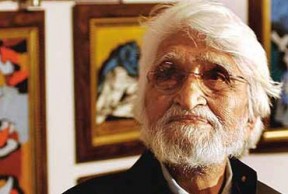Just last month, Maqbool Fida Husain was busy giving telecon interviews denying that his most recent painting, posted on the Internet immediately after Mamata Banerjee’s landslide victory in the assembly polls, had anything to do with depicting the TMC supremo as Maa Durga. “I have depicted India, to express that woman power is on the rise,” the artist had said in a newspaper interview. “My concern is the entire country – India. I admire it, and love depicting it through drawing which is my real language.”
As news came in that the 96-year-old artist had passed away in London early morning today, the irony that he had been living in a self-imposed exile since 2006 after receiving death threats from Hindu fundamentalists could not be lost on anyone. The paintings depicting Hindu deities like Saraswati and Durga in allegedly ‘sexual postures’, for which he was called ‘anti-national’ and ‘anti-Hindu’, were created in 1970, but did not become an issue until 1996, when they were printed in Vichar Mimansa, a Hindi monthly magazine. What followed was enough to force Husain to leave the country – a series of court cases, ransacking of his Mumbai home and vandalising of his artworks at various exhibitions and finally a non-bailable warrant for ‘hurting Hindu sentiments’.
The artist, who was called the ‘Picasso of India’ by Forbes magazine left the country stating that ‘matters are so legally complicated that I have been advised not to return home’ and was living between Dubai and London but continued to express a strong desire to return to India, despite accepting the offer of Qatar citizenship in January 2010.
That he remained clued in to India’s political and social scene was also evident when a painting depicting ‘India crushing the demon of corruption’ was published in a South India daily during the time that Anna Hazare was on a fast.
Apart from this serious side, Husain also openly flaunted his love for Indian cinema quite often. He was first attracted to Bollywood with the Hindi blockbuster Hum Aapke Hain Kaun – which he claimed to have watched 73 times – that inspired his Gajagamini series featuring actor Madhuri Dixit. His fascination changed with time, and so did the actresses he painted – Tabu, Amrita Rao, Vidya Balan and the newest face in tinseltown Anushka Sharma.
But much before Husain became famous for his controversies and candour, for his trademark horses and million-dollar deals, he had rightfully claimed his place as India’s most recognised painter and had made a major contribution to Indian art. Born in Pandharpur, Madhya Pradesh on September 17, 1915, his association with painting began at an early age – he learnt the art of calligraphy and practiced the Kulfic Khat with its geometric forms. He also learnt to write poetry. As a 20-year-old, he moved to Mumbai, determined to become an artist and joined Sir J J School of Arts for one year.
In 1937, he started his career painting cinema hoardings for a livelihood and his painting ‘Sunhera Sansaar’ at the 1947 annual exhibition of the Bombay Art Society, which won an award, marked his entry as a known artist. It was when F N Souza, founder of the revolutionary Progressive Artists Group, invited him to join them in 1947 that he blossomed into an artist of repute. In 1952, his first solo exhibition was held at Zurich and over the next few years, his work was widely seen in Europe and USA.
Accolades followed one after another. In 1955, he was awarded the Padma Shree, made his first film Through The Eyes of a Painter that won a Golden Bear at the Berlin Film festival in 1967, was a special invitee along with Pablo Picasso at the Sao Paulo Biennale in 1971, was nominated to the Rajya Sabha in 1986 and was awarded the Padma Vibhushan in 1991. He went on to become the highest paid painter in India, with a single canvas fetching up to $2 million at a recent Christie’s auction.
It’s no wonder then, that he could make news even in absentia. Supporters have hosted dharnas and held parallel shows of his work when, succumbing to threats, India Art Summit organisers chose not to include Husain’s artworks in the country’s foremost art fair in all its three editions.
Not that Husain would have wanted the hullabaloo over his absence. All he asked was to be able to come back to the land that he loved. All he longed for was to be able to live and paint in his own country.
Poonam Goel is a freelance journalist and has covered the arts for over 15 years. She contributes on visual arts for various newspapers, magazines and online media. More about her on Story Wallahs. Write to her @
poonamgoel2410@gmail.com







A full, rich and gifted life. RIP
Lovely post on a great artist
Great artist of agreat counry.